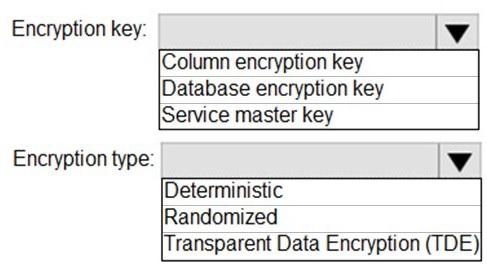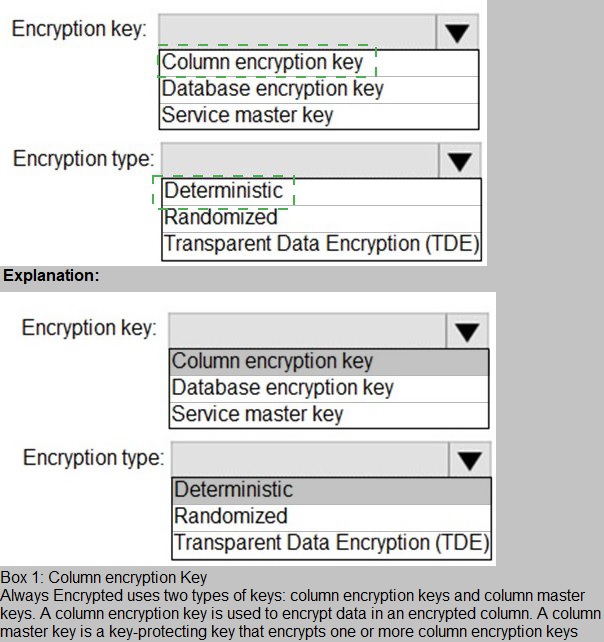
- Email support@dumps4free.com

Topic 5: Misc. Questions
You have an Azure SQL database named DB1 that contains two tables named Table1 and
Table2. Both tables contain a column named a Column1. Column1 is used for joins by an
application named App1.
You need to protect the contents of Column1 at rest, in transit, and in use.
How should you protect the contents of Column1? To answer, select the appropriate
options in the answer area.
NOTE: Each correct selection is worth one point

You have 20 Azure SQL databases provisioned by using the vCore purchasing model.
You plan to create an Azure SQL Database elastic pool and add the 20 databases.
Which three metrics should you use to size the elastic pool to meet the demands of your
workload? Each correct answer presents part of the solution.
NOTE: Each correct selection is worth one point.
A.
total size of all the databases
B.
geo-replication support
C.
number of concurrently peaking databases * peak CPU utilization per database
D.
maximum number of concurrent sessions for all the databases
E.
total number of databases * average CPU utilization per database
total size of all the databases
number of concurrently peaking databases * peak CPU utilization per database
total number of databases * average CPU utilization per database
Explanation:
CE: Estimate the vCores needed for the pool as follows:
For vCore-based purchasing model: MAX(utilization per DB>, A: Estimate the storage space needed for the pool by adding the number of bytes needed
for all the databases in the pool.
Reference:
https://docs.microsoft.com/en-us/azure/azure-sql/database/elastic-pool-overview
You have an Azure SQL database. The database contains a table that uses a columnstore
index and is accessed infrequently.
You enable columnstore archival compression.
What are two possible results of the configuration? Each correct answer presents acomplete solution.
NOTE: Each correct selection is worth one point.
A.
Queries that use the index will consume more disk I/O.
B.
Queries that use the index will retrieve fewer data pages.
C.
The index will consume more disk space.
D.
The index will consume more memory.
E.
Queries that use the index will consume more CPU resources.
Queries that use the index will retrieve fewer data pages.
Queries that use the index will consume more CPU resources.
Explanation:
For rowstore tables and indexes, use the data compression feature to help reduce the size
of the database. In addition to saving space, data compression can help improve
performance of I/O intensive workloads because the data is stored in fewer pages and
queries need to read fewer pages from disk.
Use columnstore archival compression to further reduce the data size for situations when
you can afford extra time and CPU resources to store and retrieve the data.
You have SQL Server on an Azure virtual machine that contains a database named DB1.
You have an application that queries DB1 to generate a sales report.
You need to see the parameter values from the last time the query was executed.
Which two actions should you perform? Each correct answer presents part of the solution.
NOTE: Each correct selection is worth one point.
A.
Enable Last_Query_Plan_Stats in the master database
B.
Enable Lightweight_Query_Profiling in DB1
C.
Enable Last_Query_Plan_Stats in DB1
D.
Enable Lightweight_Query_Profiling in the master database
E.
Enable PARAMETER_SNIFFING in DB1
Enable Last_Query_Plan_Stats in the master database
Enable Last_Query_Plan_Stats in DB1
You have an on-premises app named App1 that stores data in an on-premises Microsoft
SQL Server 2016 database named DB1.
You plan to deploy additional instances of App1 to separate Azure regions. Each region will
have a separate instance of App1 and DB1. The separate instances of DB1 will sync by
using Azure SQL Data Sync.
You need to recommend a database service for the deployment. The solution must
minimize administrative effort.
What should you include in the recommendation?
A.
Azure SQL Managed instance
B.
Azure SQL Database single database
C.
Azure Database for PostgreSQL
D.
SQL Server on Azure virtual machines
Azure SQL Database single database
Azure SQL Database single database supports Data Synchttps://docs.microsoft.com/en-us/azure/azure-sql/database/features-comparison
| Page 10 out of 44 Pages |
| Previous |